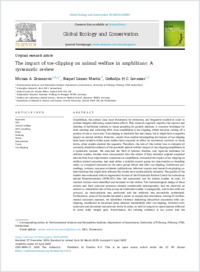The impact of toe-clipping on animal welfare in amphibians: a systematic review
DOKPE
- Zemanova, Miriam A. ORCID University of Fribourg
- Martín, Raquel Lázaro Independent Research Assistant, Freiburg im Breisgau 79199, Germany
- Leenaars, Cathalijn H.C. Institute for Laboratory Animal Science, Hannover Medical School, Hannover 30623, Germany
- 2025
Published in:
- Global Ecology and Conservation. - Elsevier BV. - 2025, vol. 59, p. e03582
English
Amphibians, the animal class most threatened by extinction, are frequently studied in order to provide insights informing conservation efforts. This research regularly requires the capture and marking of individual animals or tissue sampling for genetic analyses. A common technique for both marking and collecting DNA from amphibians is toe-clipping, which involves cutting off a portion of one or more toes. Toe-clipping is relatively fast and cheap, but it might have a negative impact on animal welfare. However, results from studies investigating the impact of toe-clipping have been variable; while some studies have reported no effect on movement, survival, or stress levels, other studies showed the opposite. Therefore, the aim of this review was to evaluate all currently available evidence of the potential animal welfare impact of toe-clipping amphibians in a systematic manner. We searched the Web of Science, BioOne, and Agricola databases for relevant studies. Studies were incorporated into the review if they included original empirical data derived from experiments conducted on amphibians, evaluated the impact of toe clipping on welfare-related outcomes, and used either a suitable control group (no intervention or handling only), or compared outcomes in the same group before and after toe-clipping. Conference proceedings, reviews, non-peer-reviewed publications, informal reports and research employing co-interventions that might have affected the results were systematically excluded. The quality of the studies was evaluated with an augmented version of the SYstematic Review Centre for Laboratory animal Experimentation (SYRCLE)’s bias risk assessment tool for animal studies. In total, 14 relevant articles were identified and included in this review. The methodological design of these articles and their outcome measures showed considerable heterogeneity, and we observed an unclear or substantial risk of bias across all examined studies. Consequently, and in line with our protocol, no meta-analysis was performed and the evidence was narratively synthesised. Furthermore, none of the studies included a power or sample size calculation. Among 44 welfare-related outcomes assessed, we identified evidence indicating discomfort associated with toe-clipping, manifested as decreased jump distance immediately after toe-clipping, elevated corticosterone and decreased testosterone levels in urine, as well as long-term repercussions reflected in lower daily weight gain. Nevertheless, the existing evidence is too scarce and the methodological design of available studies too heterogeneous to reliably conclude that there is a welfare impact of toe-clipping amphibians. Since the quality of the current evidence remains questionable, there is a critical need for adequately powered, high-quality studies that report reliable and pertinent outcome measures to accurately determine the effects of this still popular marking and sampling method. Until more robust evidence is obtained, the impacts of toe-clipping on the welfare of amphibians used in research and the integrity of study results cannot be conclusively confirmed or dismissed. Following the precautionary principle as well as the legal requirements to implement the 3Rs (Replacement, Reduction, Refinement) in research, it may be preferable to use less invasive methods for marking and DNA collection purposes in amphibians in place of toe-clipping, whenever feasible, although case-by-case decisions for each study might be necessary.
- Faculty
- Faculté des sciences et de médecine
- Department
- Département de Géosciences
- Language
-
- English
- Classification
- Biology, life sciences
- License
- Open access status
- gold
- Identifiers
-
- DOI 10.1016/j.gecco.2025.e03582
- ISSN 2351-9894
- Persistent URL
- https://folia.unifr.ch/unifr/documents/331739
Statistics
Document views: 90
File downloads:
- 25-zemanova_et_al-globecolcons: 134
